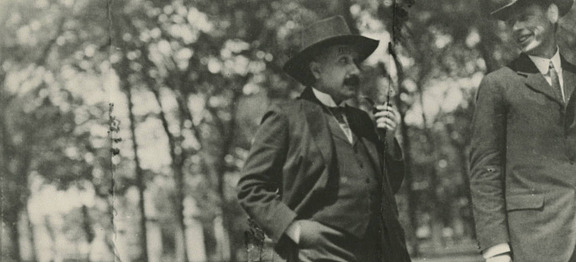Acquiring the Land
When considering the acquisition of land, the founders focused on locating the Institute in an area with ready access to a world-class library, proximity to other institutions of learning, and the opportunity for further expansion to promote institutional atmosphere and spirit. After much discussion, the Buildings and Grounds Committee determined that the Princeton vicinity would be ideal because of the opportunity for social and scholarly contacts and access to university surroundings.

Veblen and Flexner
Oswald Veblen, a Norwegian-American topologist who was a faculty member at Princeton University for twenty-seven years before becoming the first member of the Institute Faculty (1932–60), was instrumental in the Institute’s acquisition of land in Princeton. When he first learned of the Institute in an announcement in the New York Times in 1930, Veblen wrote to the Founding Director, Abraham Flexner, suggesting that the new Institute should be located in the borough or township of Princeton “so that you could use some of the facilities of the University and we could have the benefit of your presence.”
Flexner took Veblen’s suggestion under consideration, and in October 1932, he wrote: “I have it in mind now to go down to Princeton quietly for a week or so for the purpose of familiarizing myself with the general situation, for that may help us in our final choice. I should like to be away from undergraduate activities and close to graduate activities.”
In 1934, Veblen wrote to Flexner, stressing the importance of purchasing more land than might be deemed necessary and saying, “There is no educational institution in the United States which has not in the beginning made the mistake of acquiring too little rather than too much land.”
Olden Farm

It took more than five years from the Institute’s founding for a decision to be made to locate the Institute on Olden Farm, near a Quaker meeting house on a settlement known as Stony Brook in Princeton. Flexner was initially opposed to the purchase of the property, saying, “I am quite clear that at this moment we have neither the time nor the money to bother about the Olden Manor and the Olden Farm ... It is my conviction that we will never have any academic buildings on the farm, and I have such grave doubts as to the use of the Manor for social purposes..."
By 1936, 256 acres had been purchased for a total of $290,000, including the two-hundred-acre Olden Farm, with Olden Manor—the former home of William Olden and the residence of the Institute’s Director since 1940—as well as a large, working barn. Veblen continued to explore local land for sale, and over the next few years he bargained with local landowners to help the Institute acquire a total of 693 acres, including the Institute Woods.
In 1936, the Buildings and Grounds Committee reported to the Board of Trustees that they had purchased a “substantial acreage in Princeton” adequate for any immediate and future needs. Nine years later, with the purchase of the Maxwell estate under Frank Aydelotte, Director of the Institute from 1939 to 1947, the Institute’s land acquisition was completed. Aydelotte wrote to Herbert H. Maass, an Institute Trustee: “I think this is the psychological moment to close the deal. With this tract in our possession, the Institute will have one of the finest pieces of educational real estate that I know of anywhere.”
